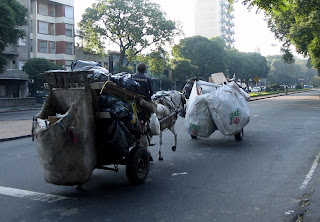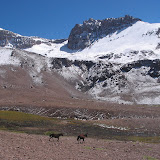Overall, I've really enjoyed my time and semester in Uruguay, and I want to "aprovechar" my time here. However, sitting in a three hour class after three hour class that could usually be condensed into a three minute lecture at Middlebury, I started to long for a stimulating class. More so, I was wondering if another semester down here was the best way to aprovechar my four year once-in-a-lifetime education for which my parents and Middlebury's endowment have scraped together about $250,000, which Ronald Liebowitz reminded me of with his inspiring "Welcome to Middlebury" speech. My conclusion? I have my whole life to return to Montevideo or another place in Latin America to work, travel or live if I want to. I have four years at Middlebury and "tá." That's it.
Now this is not to say the public university system is bad down here. On the contrary, it's pretty good with a lot of bright students, but it has a completely different structure geared more towards the long run. It seems very little emphasis is put on the "in-class" learning (most of what I've learned is from the readings), and much more on learning-by-doing. To graduate, students have an average of four to five years of class, sometimes an internship or two and several research projects of a range from 50-150 pages each (single spaced), depending on their own initiative. Essentially, on top of class, you have to write four or five theses. Add in a job, and the average student probably takes 7-8 years to graduate.
When you graduate, you have a well-respected degree, probably the equivalent of a Master's in the U.S., a good education and can get a good job. Supposedly, students graduating from the Econ school are recruited by the World Bank or IMF to work in Washington (unfortunately, Middlebury only lets us study in the Humanities school, which rumor has it is a century behind the other schools...I believe it). Bottom line, with a system geared more towards the long run in producing a person qualified to work in what they're studying, it's difficult to aprovechar if you're staying only a semester or a year, especially if you're studying something you don't study...I'm an International Politics and Economics major studying History down here.
Other news. A few weekends back I spent a short but packed weekend in Buenos Aires, and who would it turn out is studying in Buenos Aires? Alejandro Quiros, my long lost Costa Rican host brother. Turns out he got accepted to study at the University of Buenos Aires (one of the most prestigious universities in Latin America) where he's studying Economics. I met up with him and we got to catch up like old times, although he's become quite the aspiring intellectual. Within two minutes of seeing each other he moved the conversation on to discussing economic, political and social ideas, theories and policies, Neoliberalism, Marxism, etc. It was great to see him and catch up on our lives. Unfortunately I forgot to take a picture, but rest assured, he looks just like he did in Portland except for a lone dread that is embedded in his curls.
Non-news. Life in general has settled into a pretty regular routine. Classes four nights a week. Internship two days of the week. The rest of the time is filled with studying, getting together with friends for some mate and cookies (a mother of all Uruguayan traditions) or getting caught in a conversation with my host Mom. Yesterday I sat down at the table with her for some coffee and my daily fill of dulce de leche (caramelized condensed milk aka crack cocaine) and we ended up talking about everything from family and relationships to crime, suicide and depression (all while watching two hours of cartoons).
Despite being such a laid back country, Uruguay has one of the highest rates of depression and suicide in the world. I've started to wonder if it's because it's such a laid back country. Things are so laid back here that frequently there's not much going on. Some are juggling work, school, learning English and budgeting a monthly $250 salary that they have little time to get together with friends. The sense I've gotten from some people people is that there's too much solitude in their lives. Being from the U.S. and recognizing an opportunity for exploitation when I see one, I do so by talking to people who are usually more than eager to engage you in conversation and drill you about what you think of Uruguay. Many are often puzzled that someone from the U.S. would ever want to come to their country and they talk about how they hope to one day live in the U.S. or Spain. Nevertheless, while a significant portion of the country's youth is abroad (it's the oldest country in Latin America), most find their way back here to settle down.
Relating this all back to my host Mom and family, I'm very happy to be with a family down here. Sure there lots of familial customs that strike me as odd or inconvenient, such as the prep-school open door policy when someone of the opposite sex is in your room (friend or more). When my host Mom established the rule at the beginning of the semester, she said her son usually went to a hotel which seemed to work for him (thanks for the advice Mom!). From what I've gathered, it's a pretty universal rule in this country. A friend was complaining about the policy that she had no privacy when she was in a relationship, but she's resolute and implementing the exact same policy when she has kids. In general, my family has been incredibly nice and I always have some one there to talk to if I want. My respect for them has only grown with time too, both in the sense that they are a tight family and took me right in, but that they give me plenty of independence while still looking out for me.
On that note, let me leave you the top ten favorite dishes a friend of mine here excitedly rattled off one day:
- Rice, tuna and mayonnaise
- Beef milanesa (battered and fried/baked in oil) with mashed potatoes and mayonnaise (on everything)
- Beef milanesa with rice and mayonnaise (ditto)
- Chicken milanesa with rice and mayo
- Chicken milanesa with mashed potatoes and mayo
- Ham and cheese milanesa with rice/mashed potatoes and mayo
- Fish milanesa with rice/mashed potatoes and mayo
- Milanesa with rice/mashed potatoes dulce de leche and mayo
- Dulce de leche (straight)
- Mayo (straight)

















